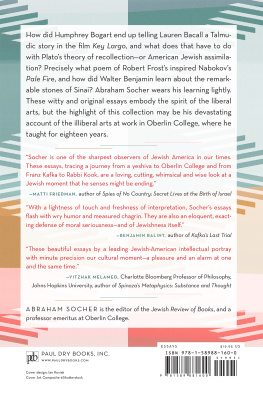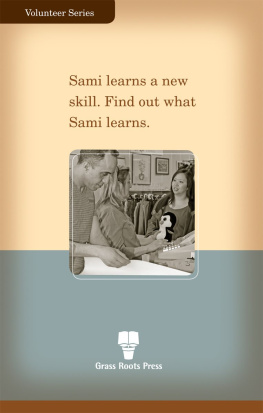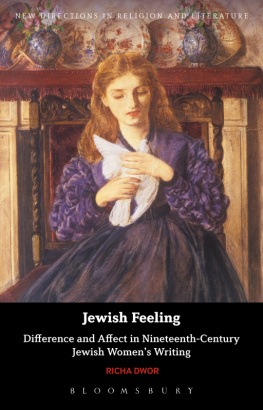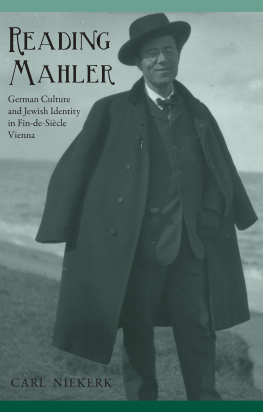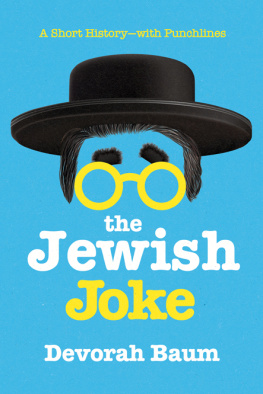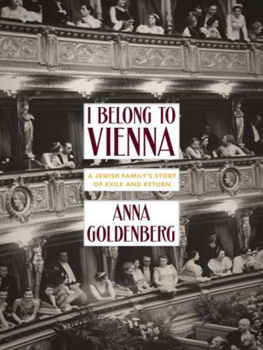JEWISH DIFFERENCE AND THE ARTS IN VIENNA
GERMAN JEWISH CULTURES
Editorial Board:
Matthew Handelman, Michigan State University
Iris Idelson-Shein, Goethe Universitt Frankfurt am Main
Samuel Spinner, Johns Hopkins University
Joshua Teplitsky, Stony Brook University
Kerry Wallach, Gettysburg College
Sponsored by the Leo Baeck Institute London
This book is a publication of
Indiana University Press
Office of Scholarly Publishing
Herman B Wells Library 350
1320 East 10th Street
Bloomington, Indiana 47405 USA
iupress.indiana.edu
2019 by Caroline A. Kita
All rights reserved
No part of this book may be reproduced or utilized in any form or by any means, electronic or mechanical, including photocopying and recording, or by any information storage and retrieval system, without permission in writing from the publisher. The paper used in this publication meets the minimum requirements of the American National Standard for Information SciencesPermanence of Paper for Printed Library Materials, ANSI Z39.48-1992.
Manufactured in the United States of America
Cataloging information is available from the Library of Congress.
ISBN 978-0-253-04053-4 (cloth)
ISBN 978-0-253-04056-5 (ebook)
1 2 3 4 5 23 22 21 20 19
For Dan,
with love and gratitude.
CONTENTS
T HERE ARE TWO STORIES ABOUT THE BEGINNING OF this book. The first story is told by my father. It involves a car ride from Boston to Buffalo when I was nine years old, during which he played for me one of his favorite recordings of Gustav Mahlers Second Symphony. According to his account, I fell asleep. I prefer the second story.
This one starts on a fateful winter evening, when I first walked into Viennas famed concert hall, the Musikverein. I had arrived in the Austrian capital with a smattering of German, my viola in tow, and dreams of walking the streets that Beethoven and Mozart had once roamed. Within the first few weeks it become clear to me that I would spend more time in the concert hall than in the practice room. And that is how I found myself on a Thursday evening in the standing room section of the Groer Saal, listening with breathless urgency to the opening bars of Mahlers Second. This time, I was hooked.
There is an oft-quoted anecdote from Mahler that he struggled for a long time to find the proper conclusion to this work. It was only at the funeral of the conductor Hans von Blow, when he heard Friedrich Klopstocks hymn Resurrection, sung by the church choir that it struck him, he claimed, like the immaculate conception! To say that this book came to me in a similar strike of inspiration would be adding a bit too much poetic license to this story. But the evening left a lasting impression on me. I couldnt stop thinking about the powerful questions Mahler was asking in this work: What is life? What is death? Have we any continuing existence? Is it all an empty dream, or has this life, this death, a meaning? And even more compelling to me was another question: how was music telling this story?
My fascination for the intersections of music and narrative, philosophy and religious quests, sparked that night in Vienna, has led me on an incredible journey. It inspired my application for a Fulbright Grant, which gave me the opportunity to undertake in-depth study of Mahlers world and his intellectual friendship with the poet and philosopher Siegfried Lipiner. This project led me back to Vienna, and later on to Berlin, Marburg, and Stockholm in search of Lipiners lost archive. And it eventually led to this book, which draws their works into conversation with the music and biblical dramas of three other German-Jewish artists, Arnold Schoenberg, Richard Beer-Hofmann, and Stefan Zweig, who shared with Mahler and Lipiner a passionate belief in the power of music to transform the individual and society.
As I began to write about this book, I was struck by how the underlying message in these works still resonates today, in a world that is so deeply divided on religious, cultural, and ideological grounds. To the question that each of the artists in this book asks, how do we live on in the face of suffering, there is only one answer: community. This project has been a constant and comforting reminder to me of how art can create a space to see beyond differences and to recognize our shared humanity.
I AM DEEPLY GRATEFUL TO ALL THE PEOPLE who have supported me throughout this books many stages and to the institutions whose financial support made this project possible, beginning first of all with Indiana University Press and the Leo Baeck Institut London, sponsor of the German Jewish Cultures Series. To Dee Mortensen, Paige Rasmussen, Rachel Rosolina, and series editors Kerry Wallach, Sam Spinner, Matthew Handelman, Iris Idelson, and Joshua Teplitsky, thank you for guiding me through the process and making this book a reality. To Kate Aid, thank you for helping me bring the pieces together.
Research for this book was supported by a Franz Werfel Grant from the sterreichischer Austauschdienst (OeAD). I am indebted to Konstanze Fliedl and Monika Meister of the University of Vienna for their support during my grant period and to the dedicated Werfelianer who offered such helpful feedback during my workshop. Thank you to Klemens Renoldner of the Stefan Zweig Centre, Salzburg, for pointing me toward helpful sources during my research. To Arthur Spiegler and Ingemar Sderberg, thank you for your personal insights into Lipiners life during the early stages of my research.
I am very appreciative of the guidance I received in libraries and archives while writing this book. Thank you to Eike Fess and Therese Muxeneder of the Arnold Schoenberg Centre for the assistance with Schoenbergs archive and for the opportunity to present parts of this project at the Schoenberg Symposium in October 2015. I am also grateful to the Schoenberg family, Bernd Reifenberg of the University of Marburg, Alena Parthonnaud of the Mdiathque Musicale Mahler, Paris, and to the staff of the Wienbibliothek im Rathhaus, the Austrian Theater Museum, the Music Collection of the Austrian National Library, and the Houghton Library at Harvard University for their assistance in procuring the images that appear in this book.
Thank you to my advisors at Boston College and Duke University who shaped this project in its very beginnings, Michael Resler, Jeremiah McGrann, Bryan Gilliam, James Rolleston, Bill Donahue, and Daniel Foster. My study of Lipiner and his relationship to Mahler benefited greatly from conversations with Morten Solvik, Stephen Hefling, and Jason Starr. To the many colleagues in the field of German Studies who generously gave their time to read my work and offer helpful adviceespecially Carl Niekerk, Abigail Gillman, and Jonathan Hessthank you for your willingness to discuss this project with me as it took shape and for supporting my research in so many ways. I also extend my gratitude to Ann Marie Rasmussen, for your practical advice on the publication process and to Sylvia Schmitz-Burgard and my many wonderful colleagues at the College of the Holy Cross for your enthusiasm and guidance in my first years out of grad school.
I also feel fortunate to have such thoughtful and generous colleagues at Washington University in St. Louis. To Lynne Tatlock, Matt Erlin, Jennifer Kapcyznski, Erin McGlothlin, Gerhild Williams, Paul Michael Ltzler, Kurt Beals, and Christian Schneider, thank you for your mentorship, encouragement and helpful advice. To Anne-Marie McManus and Melanie Micir, who provided invaluable feedback on my writing and moral support (virtually and in person!) over the last few years, I am so very grateful. Thank you to Patrick Goff and Amy Braun for your meticulous work in helping me keep this project organized. Finally, I extend my appreciation to the Center for the Humanities for sponsoring the summer writing retreats and proposal writing workshops that introduced me to such a welcoming and supportive community of scholars here at Wash U.



